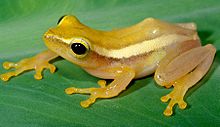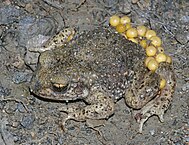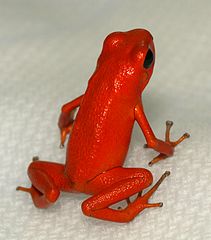The breeding habits of a poorly-studied treefrog have recently grabbed the attention of herpetologists and amphibian enthusiasts. Although it is small in size and lacks a common name, Chiromantis hansenae is quite special. Recent research has revealed it to be the only Southeast Asian treefrog known to provide parental care to its eggs. Furthermore, it breaks the typical rules that apply to most other egg-guarding frogs in important ways. Very little is known about Chiromantis hansenae, which until now was thought to be an “un-remarkable” little frog – a clear sign that important discoveries await those willing to search.
Eggs Die Without Mom’s Care
Chiromantis hansenae’s unexpected egg-brooding behavior was first observed by researchers from the National University of Singapore. Writing in the journal Ethology (V. 119, N. 8, p 671-679), they describe how females deposit egg masses in trees and then cover the eggs with their bodies. Egg-attending treefrogs sometimes descend to the ground and soak for a time in nearby ponds, after which they return and re-position themselves above the eggs. This behavior apparently supplies the eggs with water and also limits the amount of water lost via evaporation…most of the egg masses from which females were removed (by researchers) dried up and failed to hatch.
Chiromantis hansenae differs from most other egg-brooding frogs in several important ways. In other species, few large eggs are produced, and the male provides most or all of the parental care (please see photo of male Midwife Toad carrying eggs). Such eggs are generally deposited on land, and direct development (from egg to small frog) is typical. Chiromantis hansenae, by contrast, produces many tiny eggs and deposits them above-ground, and tadpoles rather than small frogs emerge from the eggs.
Conservation Implications
Why has this unique breeding strategy evolved, and how many other species rely upon it? Answering such questions is crucial if we are to understand and conserve the world’s frogs, many of which are facing an extinction crisis.
That such a small, unassuming frog could hold these secrets should inspire us to look at all creatures with deep respect and interest. One never knows where the next unforeseen discovery will arise, or how important it will be from a conservation perspective. Despite Southeast Asia’s incredible diversity of amphibians, the study mentioned above is the first to closely examine parental care in any of the region’s frogs.
Unfortunately, little is known of Chiromantis hansenae’s natural history; the range, usually given as Thailand and Cambodia, is poorly-defined. The IUCN lists this frog as “data deficient”, and some herpetologists doubt that it is a distinct species, classifying it instead as the widely-ranging C. vittatus (note: the first photo, above, is of C. vittatus; you can see a video clip of C. hansenae here ).
Related Frogs
Chiromantis hansenae is classified in the family Rhacophoridae, along with several treefrogs that are popularly-kept in captivity by amphibian enthusiasts. Included among them are two of my personal favorites, the Chinese Flying Frog (Rhacophorus dennysi, please see photo) and the African Gray Foam Nest Frog (Chiromantis xerampelina).
Further Reading
Tree Dwelling, Wood-Eating tadpoles Discovered!
The Fang-bearing Tadpoles of the Vampire Frog
 That Reptile Blog – Reptile, Amphibian and Exotic Pet Care and Information
That Reptile Blog – Reptile, Amphibian and Exotic Pet Care and Information





